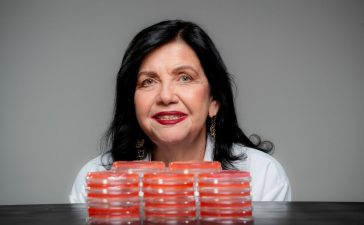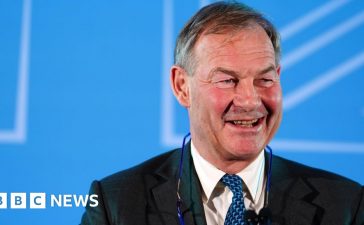‘Putting together an engine that has taken over a billion pounds of investment and running it for the first time – that’s a thrill,’ says Simon Burr. He’s the man in charge of engineering and technology at Rolls-Royce, the FTSE 100’s flagship manufacturing company.
He is talking to me in the control room next to TestBed 80, a vast, cathedral-like space at Rolls’ aero-engine works just outside Derby.
Burr is describing his emotions when he and his team recently tested the firm’s new UltraFan demonstrator engine at full power for the first time. He talks about his beloved UltraFan – an engine that Rolls-Royce hopes will be behind the next generation of super-efficient aircraft – the way a father would about a favourite child. As well he might, because it is at the heart of a remarkable renaissance by Rolls-Royce.
In the pandemic, the firm fell into such dire straits it almost went bankrupt – and not for the first time in its long and often troubled history.

Ruth Sunderland is shown around the Derby site by Rolls-Royce’s Simon Burr
But, under new Anglo-Turkish chief executive ‘Turbo’ Tufan Erginbilgic, who took over in January 2023, its shares have risen about 300 per cent. They are up about 37 per cent this year alone and recently hit a record high when Erginbilgic said he would restore dividend payments for the first time since the pandemic.
Less than two years into his tenure, it is still early days for him at the company, whose engines drive passenger jets, fighter planes and submarines.
However, Erginbilgic appears to be succeeding where a string of predecessors failed: in translating Rolls’ undeniable technical excellence into financial returns.
The question for investors is whether the profits engine can keep up at this clip. Will Tufan prove a genuine miracle man – or is it another mirage?
The company has been at the forefront of engineering for 120 years, going back to when the Honourable Charles Rolls joined forces with Sir Henry Royce.
And today UltraFan is the largest demonstrator aero engine in the world. It has a diameter of 11 feet eight inches, with beautifully curved, Tiffany blue blades.
At full power, it has 85,000lbs of thrust. Once in service, it will be able to run on 100 per cent sustainable aviation fuel, made from waste such as cooking oil.
The control room where the test run was monitored looks like the console deck from the Starship Enterprise. The team includes highly trained apprentices.
‘We can sample up to 2,000 bits of information a second, so you end up with terabytes of data,’ says Burr. A human couldn’t find their way through that. We use artificial intelligence and machine learning looking for subtle changes.’
Engines have to be tested to make sure they can cope with ice, sand and other hazards including birds. This is done by pelting them with dead ducks, their size and weight strictly regulated.
‘They come from a farm, where they are grown to the right weight – they have to be two and a half pounds,’ Burr explains.
‘We simulate a worst case scenario, when you take off and hit a flock of birds. We have to be very scientific about it, they have to be fired in at very high speed.
‘We plot migratory bird patterns around the world. Every time there is a bird strike we record it. From the imprint and the DNA we report it to the Natural History Museum, which will give us a reading on the bird type.’ People do, he says, sometimes write in about the birds, but human safety takes priority.

Touring the Derby works, the beating heart of Erginbilgic’s empire, is an exercise in awe
‘Our job is that, when you get on a plane, all you are worried about is the menu,’ he says. Perhaps not duck a l’orange, then.
The test bed is the largest and smartest on the planet. There are microphones along the sides, enabling engineers to listen to the slightest anomaly in the roar of the engine tones.
The 7,500 square metre test bed was built during the pandemic at a cost of about £90 million.
‘We spent all that money because the trend on engines is for bigger and bigger fans. They are quieter and more efficient,’ says Burr.
At the Farnborough Air Show last month, where the industry hobnobs and shows off its wares, Erginbilgic outlined how UltraFan is key to his ambition to get back into supplying engines for ‘narrow body’ planes flying on short haul routes.
Rolls, he says, is working on a smaller version of the UltraFan engine that could be used in these aircraft. Unfortunately, the company came out of the highly lucrative market a decade ago, just as demand surged, in one of a number of past strategic errors.
Rolls-Royce has been making state of the art engines for more than a century, going back to the Eagle, Falcon and Hawk in the First World War. Its Merlin engines powered Hurricanes and Spitfires in the Battle of Britain. But engineering prowess on its own, without corresponding commercial acumen, is not enough.
In the early 1970s, Rolls went bankrupt because of the cost of building the RB211, then its flagship engine.
It was eventually bailed out by Ted Heath’s government, and it was at this time that the luxury car operation was spun off.

A technician at work on the UltraFan, an engine that Rolls-Royce hopes will be behind the next generation of super-efficient aircraft
The RB211 went on to be one of its best engines, the forerunner of its highly successful Trent family.
Four years ago, in the pandemic, Rolls was again flirting with financial ruin. In the autumn of 2020 it had to go cap in hand to shareholders for £2 billion of rescue capital, along with a £3 billion Government-backed debt package.
Erginbilgic is adamant he is not merely mending the firm, which he described as a ‘burning platform’. He says: ‘I’m not just re-structuring to survive, I am creating a different company that can do different and better things.’
He says when he arrived Rolls ‘frankly had no strategy’, adding: ‘I talked to top investors before I began and it was clear I needed to make a difference early on.’ How exactly, then, is he going about it?

His approach has been to take a highly detailed look at every aspect of the business – a technique he learned having turned around two businesses at his previous employer, BP.
He has set ambitious mid-term targets for 2027 – operating profits of between £2.5 billion and £2.8 billion, free cash flow of £2.8 billion to £3.1 billion, a return of capital of 16 to 18 per cent and an operating profit margin of 13 to 15 per cent. At the half year results last week, Erginbilgic told the City that he was already well on the way.
There is, he says, ‘no tolerance for mediocrity’ and adds: ‘We have changed almost every process. You need to act with high intensity at high pace and consistently. I set out to create a sense of urgency.’
He carried out an exhaustive study of how Rolls was performing against its rivals before joining, saying: ‘It took three and a half months and it really drilled down.’
He delved into internal processes and why Rolls was lagging behind its competitors, then put together a highly detailed strategy.
‘Your vision needs to be very powerful and purposeful,’ he says. ‘If nothing changes, why bother?’
Erginbilgic is rebuilding the balance sheet, pushing through an efficiency plan and improving profitability. Ultimately, though, his success depends on engineering and whether Rolls can lead the way in cleaner, quieter engines. As well as new, energy-efficient aero engines, the firm is developing methanol engines in its marine business, expected by 2026.
It has also had a breakthrough in its attempt to win the race to develop the UK’s first mini-nuclear power plant. Its design for a Small Modular Reactor (SMR) is the first to go through to the final stage of examination by UK regulators.
SMRs – low-cost reactors made from modules that can be assembled on site – are cheaper and quicker to construct than conventional nuclear power plants.
Touring the Derby works, the beating heart of Erginbilgic’s empire, is an exercise in awe.

Ambitious: Rolls-Royce’s new UltraFan engine and boss Tufan Erginbilgic
Burr shows me engines in various states of readiness, lined up along a spotless factory floor.
He is flanked by Chris Pattinson, the senior vice president who oversees assembly and testing.
‘This is the Trent XWB,’ says Pattinson. ‘These are a dream to build. The factory never stops. We assemble 30,000 parts in about 20 days.’
Rolls is investing £1 billion in improving its Trent engines. The business model is that the engine itself is sold at a loss, but Rolls receives income for service and maintenance based on hours in the air. Burr says: ‘We are being paid a standard amount per hour, so if you can eke out a longer life you will make more money.
‘We made a promise to the buyer. The Rolls-Royce logo is a promise of excellence and I come to work to ensure we deliver it.’
Every component is a miracle of form and function. I gaze at fan blades, made in Barnoldswick in Lancashire. They are of such sinuous, curved beauty they could be displayed in a gallery as a work of art. Pattinson says: ‘It is amazing aerodynamic form with incredible strength and lightness.
‘It is a beautiful thing – if things look right, they work right.’
He shows me a conical spinner that goes on the front of an engine. It has a rubber cap on the top, an invention by a Rolls-Royce engineer to stop ice forming. There is also a stripe to ensure the fan does not look static when it is moving.
Then you have the turbine blades: small marvels of engineering.
Compact enough to fit in your hand, they work in the hottest part of the engine and are formed out of a flawless single crystal grown over three months. The sense of pride and excitement at Derby is in the air. Erginbilgic wants to harness this energy behind his transformation plan.
‘Success creates belief among the workforce,’ he says. ‘If you put your vision out there, but three years later nothing has happened, your programme is dead.
‘I have changed almost everything in the company. I cannot emphasise this enough.
‘Every process you can think of in Rolls-Royce that matters has changed already.’
Can he keep up the momentum?
‘I think about this every day,’ says Erginbilgic. ‘There is a lot more on my to do list. I wish I could do it all tomorrow.’
Is now the time to buy its shares?
Rolls-Royce’s recent performance has been remarkable but it could have further to go, experts say.
‘Tufan Erginbilgic at Rolls-Royce is telling a rare recovery story that is doing what it said it would do, not simply talking hot air and making false promises,’ says Daniel Coatsworth, investment analyst at the financial platform AJ Bell.
‘He has given investors plenty of reasons to stay confident in the turnaround efforts and they have been rewarded with significant share price gains in the past few years.’
Coatsworth adds: ‘The growth opportunities are big and the company is on a roll, so it is understandable why investors might feel that they want to stick with the shares even after an almost 500 per cent rise since October 2022.
‘Smashing expectations with its latest results goes some way to justifying its premium share rating, but it also means this feat has to be repeated again and again, otherwise investors might take anything less as a reason to bank their profits.’
Justin Urquhart Stewart, founder of Seven Investment Management, says: ‘The shares have already had a phenomenal run and that pace will probably slow. But they are a good long-term stalwart of the FTSE 100.
‘The dividend has been re-instated which is positive. There has been a very good turnaround with a lot more to come.’
Stewart adds: ‘The price at the moment is high so maybe wait for it to pull back.’
DIY INVESTING PLATFORMS

AJ Bell

AJ Bell
Easy investing and ready-made portfolios

Hargreaves Lansdown

Hargreaves Lansdown
Free fund dealing and investment ideas

interactive investor

interactive investor
Flat-fee investing from £4.99 per month

Saxo

Saxo
Get £200 back in trading fees

Trading 212

Trading 212
Free dealing and no account fee
Affiliate links: If you take out a product This is Money may earn a commission. These deals are chosen by our editorial team, as we think they are worth highlighting. This does not affect our editorial independence.
Some links in this article may be affiliate links. If you click on them we may earn a small commission. That helps us fund This Is Money, and keep it free to use. We do not write articles to promote products. We do not allow any commercial relationship to affect our editorial independence.











